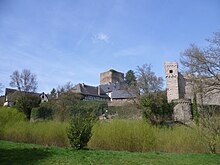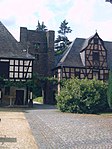Langenau Castle (Rhineland)
The Langenau Castle is an original lowland castle in the field of local church Obernhof in Rhein-Lahn-Kreis in Rhineland-Palatinate .
history
The mouth of the Gelach into the Lahn was chosen as the location for the fortification . The castle is designed in the form of a low castle, which is unusual for the region.
In 1243 the castle was first mentioned in the legacy of Countess Mechthild von Sayn , who bequeathed it to the Archdiocese of Cologne . Shortly afterwards, the archbishop enfeoffed the knight family of those zu Langenau with the fortress. The family kept the castle as an inheritance for centuries. It is possible that the family had already received the castle as a fief from Mechthild and had also been the builders of the original complex under Hildger von Langenau in the first half of the 13th century.
The original castle was transformed into a moated castle by means of a dam. Today only the square keep in Romanesque style is preserved as a component from the 13th century . The other fortifications, a curtain wall and an eight meter high shield wall with two flanking towers, have Gothic elements and were built in the 14th or 15th century. Presumably as early as the middle of the 14th century, the castle no longer served as a knight's seat, but primarily as a farmyard.
After the von Langenau family died out in 1613, the Eltz family prevailed among the Ganerbe and took control of the entire castle . Already in 1635 the zu Eltz sold the castle to the electoral Cologne secret councilor Johann Adolf Wolff Metternich zur Gracht . A large half-timbered farm building was also built in the 17th century. In 1696, Wolff-Metternich sold the plant to the Marioth family of traders and industrialists, originally from Liège , who were one of the key players in iron processing in the Lahn region. She used the complex as a residence and had it converted into a castle by 1698.
The Marioth family died in 1847 with Franz Joseph Ferdinand von Marioth. Countess Henriette von Giech , a daughter of the Prussian reform minister vom und zum Stein , acquired Langenau Castle from the estate . In 1851 she had it converted into a hospital and rescue center for neglected children .
House and estate Langenau
The Ritterhaus zu Langenau comes from the Count's House of Laurenburg and thus the early House of Nassau . The Langenauer mostly acted as close allies of the Nassau. In the middle of the 14th century they tried unsuccessfully to build another castle under the name Neu-Langenau near their ancestral castle. This led to a feud with Kurtrier , who felt threatened by the castle building. In the course of this dispute, Kurtrier seized the construction site and in 1359 the half-finished castle and a fortification between this and the old castle were razed as part of an agreement.
In 1355, under Daniel von Langenau, the Hohlenfels Castle was built as a Nassau-Merenberg fief. In addition, in the 14th century, the family also succeeded in ruling the immediate vicinity of Langenau Castle. This imperial knighthood rule was imperial direct . In the middle of the 15th century, the Langenau estates began to split up into further inheritance. In 1613 the house of Langenau died out.
Due to the Reichsdeputationshauptschluss 1803, the rule Langenau was mediated and incorporated into the Principality of Nassau-Usingen . In a letter dated October 25, 1803, the princely government forbade the payment of knight tax to the Burggrafschaft Friedberg . By princely edict, Marioth was granted a privileged place of jurisdiction . However , von Marioth lost the sovereign rights including the patrimonial jurisdiction . In order to avoid conflicts, Nassau sought to acquire power, but von Marioth did not want to sell. Nevertheless, the sovereign rights of the Marioths actually ended. The administrative and judicial functions were transferred to the Nassau office .
literature
- Alexander Thon, Stefan Ulrich, Jens Friedhoff : "Decided with strong iron chains and bolts ..." Castles on the Lahn . Schnell & Steiner, Regensburg 2008, ISBN 978-3-7954-2000-0 , pp. 88-93.
Web links
Individual evidence
- ^ Harry Münzing: The mediatization of the former imperial directors and imperial knights in the Duchy of Nassau. Diss., 1980, DNB 811022633 , pp. 125-126.
Coordinates: 50 ° 18 ′ 38.1 ″ N , 7 ° 50 ′ 34 ″ E





